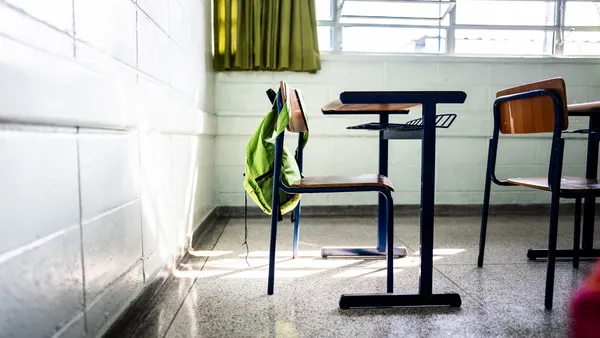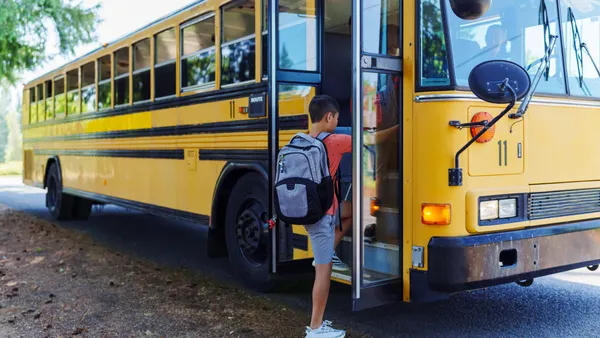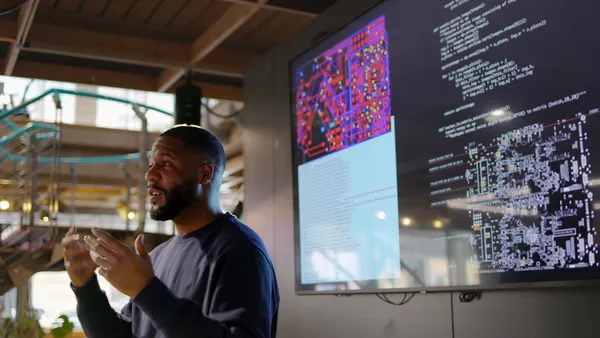Dive Brief:
- Initial findings from the NAEP School Survey — a monthly pilot collection launched by the Institute of Education Sciences and National Center for Education Statistics to gain insight into schools' available learning opportunities during COVID-19 — show almost half of White students (49%) were more likely to be learning fully in-person in January. Students of color were more likely to be learning in fully remote conditions, with 68% of Asian, 58% of Black and 56% of Hispanic students participating in that mode of learning.
- The initial data also shows economically disadvantaged students, English learners, and students with disabilities did not receive full-time in-person instruction at notably higher rates, though over 40% of schools self-reported prioritizing students with disabilities for full-time in-person instruction at grades 4 and 8. The surveys are conducted using existing National Assessment of Educational Progress infrastructure and will produce five rounds of data total.
- There were also notable differences by region, with rural areas and towns much more likely to be open for full-time, in-person instruction compared to city and suburban areas. Additionally, while more than a third of students in the South and Midwest were enrolled for full-time, in-person learning in January, that number was less than a quarter for those in the West and Northeast.
Dive Insight:
Respondents in New Hampshire, Vermont, Nebraska, Wyoming, Idaho, Oklahoma, Arkansas and Alabama reported 50% or more of their 4th-grade students received two hours or less of live instruction during remote learning.
"That was, I thought, very surprising," said Peggy Carr, associate commissioner for assessment at the National Center for Education Statistics, during a press conference. "I knew it was going to be low, but not quite that low."
However, data collectors are unsure if the data differentiates between hours of live instruction for those in a hybrid environment and those in a full remote-learning environment. For example, a student enrolled in hybrid instruction receiving two hours or less of live instruction during one day of remote learning is different from a fully remote student whose only live instruction takes place online.
Carr also said the data patterns could apply to other grades as well. Extrapolation is "certainly appropriate," she said. "We believe that 3rd-graders are not being treated differently from 4th-graders, for example."
Carr said the "most surprising fact" was that Black, Hispanic and Asian students in public schools were more likely to be receiving fully remote learning than their White counterparts in both grades 4 and 8.
Secretary of Education Miguel Cardona, ahead of the U.S. Department of Education's National Safe School Reopening Summit, urged states on Wednesday to use funding from the American Rescue Plan to create summer programs meant to address learning loss, especially for underserved communities. The plan already required districts to use 20% of their funds for addressing students' SEL needs and learning loss.
Cardona also announced the Summer Learning and Enrichment Collaborative, which is set to launch in April and serve as a professional learning community to build plans for "high-quality, evidence-based summer learning and enrichment."
Meanwhile, other nations have launched national tutoring programs. A large-scale U.S. investment proportional to that of other nations would amount to $5.3 billion, Robert Slavin, director of the Center for Research and Reform in Education at Johns Hopkins University, calculated in a blog post.
Of the $123 billion in relief funds from the American Rescue Plan, however, $1.2 billion are strictly dedicated for states, school districts and individual schools to offer evidence-based summer learning and enrichment programs, according to a press release.
Superintendents worry the funding is not recurring, and therefore may not be able to sustain long-term programs and new hires. "We know that we have our work cut out for us," said Elie Bracy, superintendent of Portsmouth Public Schools in Virginia, earlier this month.












